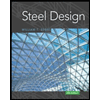
Steel Design (Activate Learning with these NEW titles from Engineering!)
6th Edition
ISBN: 9781337094740
Author: Segui, William T.
Publisher: Cengage Learning
expand_more
expand_more
format_list_bulleted
Concept explainers
Question
Problem 1. A W30 x 116 beam has
the top flange restrained against
lateral displacement and rotation
and has an unstiffened web. A point
load is applied to the top flange at
2m. From the left support. The beam
spans 12 m. Use A36 steel with yield
strength of Fy = 248 Mpa.
a. Compute the maximum value of point load
that may be applied without web yielding
occurring.
b. Compute the maximum value of point load
that may be applied without web crippling
occurring.
Properties of W30 x 116
d = 762 mm
K = 41.28 mm
bf = 266.7 mm
tf = 21.59 mm
tw = 14.33 mm
Expert Solution
This question has been solved!
Explore an expertly crafted, step-by-step solution for a thorough understanding of key concepts.
This is a popular solution
Trending nowThis is a popular solution!
Step by stepSolved in 3 steps

Knowledge Booster
Learn more about
Need a deep-dive on the concept behind this application? Look no further. Learn more about this topic, civil-engineering and related others by exploring similar questions and additional content below.Similar questions
- Compute the nominal shear strength of an M107.5 of A572 Grad 65 steel.arrow_forwardA plate girder must be designed for the conditions shown in Figure P10.7-4. The given loads are factored, and the uniformly distributed load includes a conservative estimate of the girder weight. Lateral support is provided at the ands and at the load points. Use LRFD for that following: a. Select the, flange and web dimensions so that intermediate stiffeners will he required. Use Fy=50 ksi and a total depth of 50 inches. Bearing stiffeners will be used at the ends and at the load points, but do not proportion them. b. Determine the locations of the intermediate stiffeners, but do not proportion them.arrow_forwardCompute the nominal shear strength of an M1211.8 of A572 Grade 65 steel.arrow_forward
- The given beam is laterally supported at the ends and at the 1 3 points (points 1, 2, 3, and 4). The concentrated load is a service live load. Use Fy=50 ksi and select a W-shape. Do not check deflections. a. Use LRFD. b. Use ASD.arrow_forwardA beam must be designed to the following specifications: Span length = 35 ft Beam spacing = 10 ft 2-in. deck with 3 in. of lightweight concrete fill (wc=115 pcf) for a total depth of t=5 in. Total weight of deck and slab = 51 psf Construction load = 20 psf Partition load = 20 psf Miscellaneous dead load = 10 psf Live load = 80 psf Fy=50 ksi, fc=4 ksi Assume continuous lateral support and use LRFD. a. Design a noncomposite beam. Compute the total deflection (there is no limit to be checked). b. Design a composite beam and specify the size and number of stud anchors required. Assume one stud at each beam location. Compute the maximum total deflection as follows: 1. Use the transformed section. 2. Use the lower-bound moment of inertia.arrow_forwardUse the composite beam tables and select a W-shape and stud anchors for the following conditions: Span length = 18 6 Beam spacing = 9 ft Total slab thickness = 51 2 in. (the slab and deck combination weighs 57 psf). Lightweight concrete with a unit weight of 115 pcf is used Construction load = 20 psf Partition load = 20 psf Live load = 225 psf Fy=50 ksi and fc=4 ksi A cross section of the formed steel deck is shown in Figure P9.8-9. The maximum live-load deflection cannot exceed L/360 (use a lower-bound moment of inertia). a. Use LRFD. b. User ASD.arrow_forward
arrow_back_ios
arrow_forward_ios
Recommended textbooks for you
 Steel Design (Activate Learning with these NEW ti...Civil EngineeringISBN:9781337094740Author:Segui, William T.Publisher:Cengage Learning
Steel Design (Activate Learning with these NEW ti...Civil EngineeringISBN:9781337094740Author:Segui, William T.Publisher:Cengage Learning

Steel Design (Activate Learning with these NEW ti...
Civil Engineering
ISBN:9781337094740
Author:Segui, William T.
Publisher:Cengage Learning